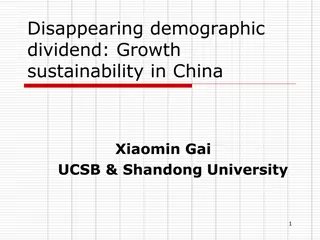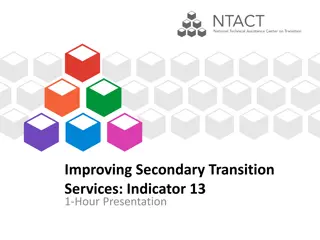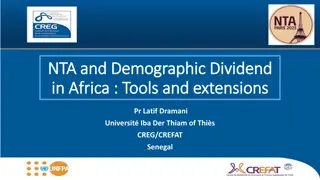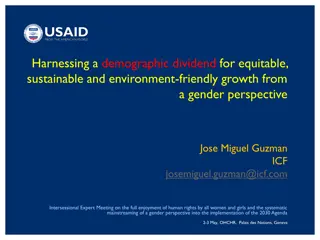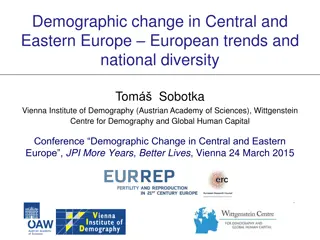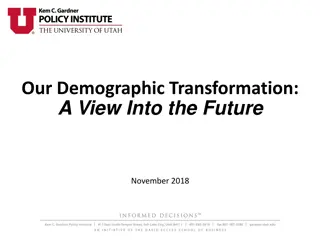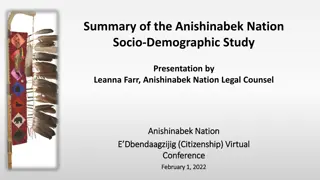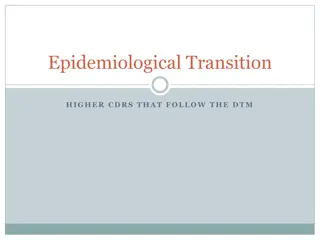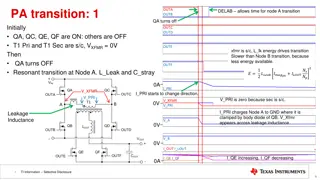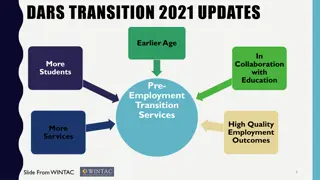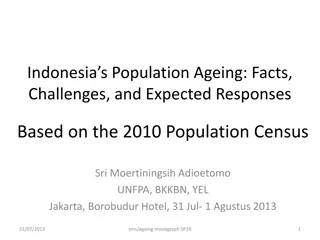Understanding the Demographic Transition Model
The Demographic Transition Model describes the shift from high birth and death rates to low rates as societies advance technologically and economically. It consists of four stages, each marked by specific characteristics and factors influencing population growth. From high mortality and fertility rates in the initial stages to declining birth rates in later stages, the model provides insights into demographic changes over time.
Download Presentation

Please find below an Image/Link to download the presentation.
The content on the website is provided AS IS for your information and personal use only. It may not be sold, licensed, or shared on other websites without obtaining consent from the author. Download presentation by click this link. If you encounter any issues during the download, it is possible that the publisher has removed the file from their server.
E N D
Presentation Transcript
WHAT IS DEMOGRAPHIC TRANSITION MODEL? It is a phenomenon which refers to the historical shift from high birth rates and high infant death rates in societies with minimal technology ,education and economic development, to low birth rates and low death rates in societies with advanced technology, education and economic development, as well as stages between these scenarios.
Founders of the theory The theory is based on the interpretation of demographic history by Warren Thompson in the year 1929 but later on a formal representation of this theory was given by Notestian in 1950s.
EXPLANATION OF THE MODEL The theory consist of 4 stages- FIRST STAGE Both the death rate and the birth rate remained very high. The population growth is highly stationary. Society was engaged in primary activities basically.
Reasons for high birth and death rate High BR Reasons High DR reasons High infant mortality Poor nutrition Lack of contraceptives Lack of medical facility Children were considered as economic assets Poor sanitation Large family was a social norm
SECOND STAGE The birth rate remains high as in the first stage The death rate shows a declining trend The population count increases at a slow pace Death rate declines due to improved nutrition, improved medical care and better sanitation measures. Zimbabwe,Kenya,Ghana, Afghanistan are in this stage.
THIRD STAGE The birth rate shows a declining trend. The death rate shows a constant trend which is little less than the second stage. The birth rate falls due to access to contraception, urbanization, reduction in subsistence agriculture, increase in education of females. Total population rises at its fastest rate at the start of this stage when the surplus of births over deaths is at its maximum. However towards the end of this stage the gap between the birth and the death reduces till birth outnumbers death. Countries like Jamaica,India,Malaysiya have witnessed low birth rates
FOURTH STAGE Both the birth rate and death rate declines. They are in balance. Birth rates may drop below replacement level as has happened in countries like Germany, Italy and Japan leading to shrinking population. Low death rate has caused ageing population problem in many developed nation Countries like Argentina,Bhutan,Mexico,Sri lanka are in this stage.
INDIA AND DEMOGRAPHIC TRANSITION MODEL India too is following the demographic transition model. Death rate began to fall after 1920 but the birth rate remained high up to 1960s resulting in huge population growth. India witnessed a small decline in population in the last decade. The population pyramid wasa wide at the bottom but by 2001 the bottom is narrowed and a bulge is moving upward suggesting fall in fertility Population dividend has been seen in population structure which is a positive indication showing less dependent population.
CRITICISM It can only predict the future of population growth pattern but can not always speak the reality. Population growth includes three primary factors i.e birth rate,death rate and migration.but this model is silent on the migration factor. This model fails to explain the exact time needed to pass from one stage to the next stage This model has shown different time period in different continents to pass through various stages. This model does not include the social factors like education of women which lowers birth rate.



